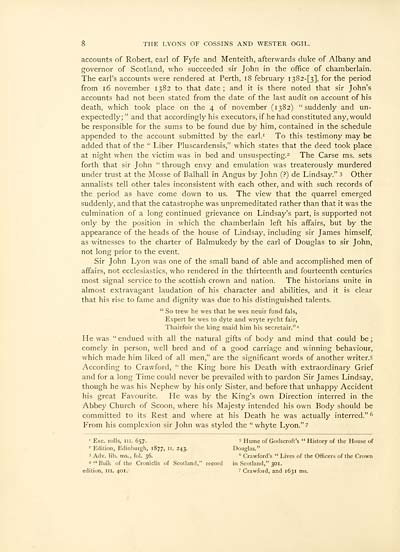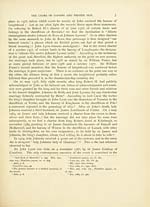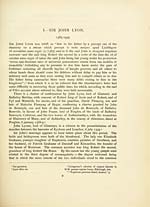Lyons of Cossins and Wester Ogil
(24) Page 8
Download files
Complete book:
Individual page:
Thumbnail gallery: Grid view | List view

8 THE LYONS OF COSSINS AND WESTER OGIL.
accounts of Robert, earl of Fyfe and Menteith, afterwards duke of Albany and
governor of Scotland, who succeeded sir John in the office of chamberlain.
The earl's accounts were rendered at Perth, iS february 1 382-[3], for the period
from 16 november 1382 to that date; and it is there noted that sir John's
accounts had not been stated from the date of the last audit on account of his
death, which took place on the 4 of november (1382) "suddenly and un-
expectedly; " and that accordingly his executors, if he had constituted any, would
be responsible for the sums to be found due by him, contained in the schedule
appended to the account submitted by the earl. 1 To this testimony may be
added that of the " Liber Pluscardensis," which states that the deed took place
at night when the victim was in bed and unsuspecting. 2 The Carse ms. sets
forth that sir John " through envy and emulation was treaterously murdered
under trust at the Mosse of Balhall in Angus by John (?) de Lindsay." 3 Other
annalists tell other tales inconsistent with each other, and with such records of
the period as have come down to us. The view that the quarrel emerged
suddenly, and that the catastrophe was unpremeditated rather than that it was the
culmination of a long continued grievance on Lindsay's part, is supported not
only by the position in which the chamberlain left his affairs, but by the
appearance of the heads of the house of Lindsay, including sir James himself,
as witnesses to the charter of Balmukedy by the earl of Douglas to sir John,
not long prior to the event.
Sir John Lyon was one of the small band of able and accomplished men of
affairs, not ecclesiastics, who rendered in the thirteenth and fourteenth centuries
most signal service to the Scottish crown and nation. The historians unite in
almost extravagant laudation of his character and abilities, and it is clear
that his rise to fame and dignity was due to his distinguished talents.
" So trew he wes that he wes neuir fund fals,
Expert he wes to dyte and wryte rycht fair,
Thairfoir the king maid him his secretair." 4
He was "endued with all the natural gifts of body and mind that could be;
comely in person, well bred and of a good carriage and winning behaviour,
which made him liked of all men," are the significant words of another writer.5
According to Crawford, " the King bore his Death with extraordinary Grief
and for a long Time could never be prevailed with to pardon Sir James Lindsay,
though he was his Nephew by his only Sister, and before that unhappy Accident
his great Favourite. He was by the King's own Direction interred in the
Abbey Church of Scoon, where his Majesty intended his own Body should be
committed to its Rest and where at his Death he was actually interred." 6
From his complexion sir John was styled the " whyte Lyon." 7
' Exc. rolls, in. 657. 5 Hume of Godscroft's " History of the House of
2 Edition, Edinburgh, 1877, II. 243. Douglas."
3 Adv. lib. ms. , fol. 36. 6 Crawford's " Lives of the Officers of the Crown
4 " Buik of the Croniclis of Scotland," record in Scotland," 301.
edition, III. 401. 1 Crawford, and 1631 ms.
accounts of Robert, earl of Fyfe and Menteith, afterwards duke of Albany and
governor of Scotland, who succeeded sir John in the office of chamberlain.
The earl's accounts were rendered at Perth, iS february 1 382-[3], for the period
from 16 november 1382 to that date; and it is there noted that sir John's
accounts had not been stated from the date of the last audit on account of his
death, which took place on the 4 of november (1382) "suddenly and un-
expectedly; " and that accordingly his executors, if he had constituted any, would
be responsible for the sums to be found due by him, contained in the schedule
appended to the account submitted by the earl. 1 To this testimony may be
added that of the " Liber Pluscardensis," which states that the deed took place
at night when the victim was in bed and unsuspecting. 2 The Carse ms. sets
forth that sir John " through envy and emulation was treaterously murdered
under trust at the Mosse of Balhall in Angus by John (?) de Lindsay." 3 Other
annalists tell other tales inconsistent with each other, and with such records of
the period as have come down to us. The view that the quarrel emerged
suddenly, and that the catastrophe was unpremeditated rather than that it was the
culmination of a long continued grievance on Lindsay's part, is supported not
only by the position in which the chamberlain left his affairs, but by the
appearance of the heads of the house of Lindsay, including sir James himself,
as witnesses to the charter of Balmukedy by the earl of Douglas to sir John,
not long prior to the event.
Sir John Lyon was one of the small band of able and accomplished men of
affairs, not ecclesiastics, who rendered in the thirteenth and fourteenth centuries
most signal service to the Scottish crown and nation. The historians unite in
almost extravagant laudation of his character and abilities, and it is clear
that his rise to fame and dignity was due to his distinguished talents.
" So trew he wes that he wes neuir fund fals,
Expert he wes to dyte and wryte rycht fair,
Thairfoir the king maid him his secretair." 4
He was "endued with all the natural gifts of body and mind that could be;
comely in person, well bred and of a good carriage and winning behaviour,
which made him liked of all men," are the significant words of another writer.5
According to Crawford, " the King bore his Death with extraordinary Grief
and for a long Time could never be prevailed with to pardon Sir James Lindsay,
though he was his Nephew by his only Sister, and before that unhappy Accident
his great Favourite. He was by the King's own Direction interred in the
Abbey Church of Scoon, where his Majesty intended his own Body should be
committed to its Rest and where at his Death he was actually interred." 6
From his complexion sir John was styled the " whyte Lyon." 7
' Exc. rolls, in. 657. 5 Hume of Godscroft's " History of the House of
2 Edition, Edinburgh, 1877, II. 243. Douglas."
3 Adv. lib. ms. , fol. 36. 6 Crawford's " Lives of the Officers of the Crown
4 " Buik of the Croniclis of Scotland," record in Scotland," 301.
edition, III. 401. 1 Crawford, and 1631 ms.
Set display mode to:
![]() Universal Viewer |
Universal Viewer | ![]() Mirador |
Large image | Transcription
Mirador |
Large image | Transcription
Images and transcriptions on this page, including medium image downloads, may be used under the Creative Commons Attribution 4.0 International Licence unless otherwise stated. ![]()
| Histories of Scottish families > Lyons of Cossins and Wester Ogil > (24) Page 8 |
|---|
| Permanent URL | https://digital.nls.uk/95518241 |
|---|
| Description | A selection of almost 400 printed items relating to the history of Scottish families, mostly dating from the 19th and early 20th centuries. Includes memoirs, genealogies and clan histories, with a few produced by emigrant families. The earliest family history goes back to AD 916. |
|---|

